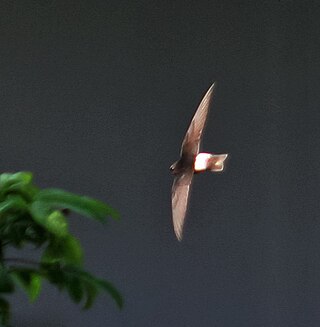
The common swift is a medium-sized bird, superficially similar to the barn swallow or house martin but somewhat larger, though not stemming from those passerine species, being in the order Apodiformes. The resemblances between the groups are due to convergent evolution, reflecting similar contextual development. The swifts' nearest relatives are the New World hummingbirds and the Southeast Asian treeswifts.

The swifts are a family, Apodidae, of highly aerial birds. They are superficially similar to swallows, but are not closely related to any passerine species. Swifts are placed in the order Apodiformes with hummingbirds. The treeswifts are closely related to the true swifts, but form a separate family, the Hemiprocnidae.

The little swift, is a small species of swift found in Africa and southwestern Asia, and are vagrants and local breeders in southern Europe. They are found both in urban areas and at rocky cliffs where they build nests in a way typical of all members of the order Apodiformes. The genus name Apus is Latin for a swift, thought by the ancients to be a type of swallow without feet. The Latin specific affinis means similar to or related to, but in this case the species that the little swift supposedly resembles is not clear from the description. A population formerly considered to be an eastern subspecies of little swift is now separated as a distinct species, the house swift.

The pallid swift is a small bird, superficially similar to a barn swallow or house martin. It is, however, completely unrelated to those passerine species, since the swifts are in the order Apodiformes. The resemblances between the groups are due to convergent evolution reflecting similar life styles.

The Pacific swift or fork-tailed swift is a species of bird that is part of the Swift family. It breeds in eastern Asia. It is strongly migratory, spending the northern hemisphere's winter in Southeast Asia and Australia. The general shape and blackish plumage recall its relative, the common swift, from which it is distinguished by a white rump band and heavily marked underparts. The sexes are identical in appearance, although young birds can be identified by pale fringes to the wing feathers that are absent in adults. This swift's main call is a screech typical of its family. It is one of a group of closely related Asian swifts formerly regarded as one species.

The brown-backed needletail, or brown needletail, is a large swift.

The wire-tailed swallow is a small passerine bird in the swallow family. It has two subspecies: H. s. smithii, which occurs throughout Africa, and H. s. filifera, which is found in southern and southeastern Asia. It is mainly resident, but populations in Pakistan and northern India migrate further south in winter. The genus name Hirundo is the Latin word for swallow. The species name smithii commemorates Christen Smith, a Norwegian botanist and geologist.

The lesser swallow-tailed swift or Cayenne swift is a species of bird in subfamily Apodinae of the swift family Apodidae. It is found from southern Mexico through Central America; in every mainland South America country except Argentina, Chile, Paraguay, and Uruguay; and on Trinidad.

The bird genus Apus comprise some of the Old World members of the family Apodidae, commonly known as swifts.
The purple needletail, or hagibas in Tagalog, is the largest swift found in the Old World. It is native to the Philippine archipelago and the Minahasa Peninsula (Sulawesi).
The Cape Verde swift or Alexander's swift is a small bird of the swift family found only in the Cape Verde Islands. It has been recorded from all the islands except Santa Luzia although it probably breeds only on Santiago, Fogo, Brava, Santo Antão and São Nicolau. It is generally common with a stable population and is not considered to be threatened. The name Alexander's swift commemorates Boyd Alexander, an English ornithologist who led two expeditions to the islands in 1897.
Bates's swift is a species of small swift in the family Apodidae which is found in western Africa.

Hirundapus is a genus of swifts in the family Apodidae. The name Hirundapus is constructed from the names of the swallow genus Hirundo and the swift genus Apus.
The Philippine spine-tailed swift, also known as the Philippine needletail or Philippine spinetail, is a species of swift in the family Apodidae. It is endemic to the Philippines found in the islands of Mindanao and Visayas. Its natural habitat is tropical moist lowland forests. It is becoming rare due to habitat loss.

The Apodinae are a subfamily of swifts and contain the following species:












